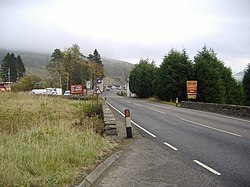Tyndrum
| Tyndrum Gaelic: Taigh an Droma | |
| Perthshire | |
|---|---|
 The main road through Tyndrum | |
| Location | |
| Grid reference: | NN330303 |
| Location: | 56°26’7"N, 4°42’36"W |
| Data | |
| Post town: | Crianlarich |
| Postcode: | FK20 |
| Dialling code: | 01838 |
| Local Government | |
| Council: | Stirling |
| Parliamentary constituency: |
Stirling |
Tyndrum (Gaelic: Taigh an Droma) is a small village in Perthshire. Its Gaelic name translates as "the house on the ridge". It lies in Strathfillan, at the southern edge of Rannoch Moor.
The village is notable mainly for being at a junction of transport routes. The West Highland Line railway from Glasgow splits approximately five miles to the south at Crianlarich, with one branch heading to Fort William and the other to Oban. Tyndrum has a station on each: Upper Tyndrum on the Fort William line and Tyndrum Lower on the Oban line. Thus unusually there are two stations serving the same small village, only a few hundred yards apart, but about ten miles apart by rail. Indeed, Tyndrum is the smallest settlement in the UK with more than one railway station. This is partly a legacy of the history of the railways in the area, after two separate railways belonging to different railway companies were built through the village. However, the main reason is geography: splitting the line in Crianlarich allows the contours of the glen to be used to avoid very steep climbs heading north or west from Tyndrum. Roads mirror this division: the A82 from Glasgow to Fort William passes through Tyndrum, and the A85 to Oban splits off just north of the village.
Tyndrum is a popular tourist village. It is on the West Highland Way, and has a campsite, hotel, bunkhouse and bed and breakfasts to accommodate walkers.
Overshadowed by Ben Lui, a Munro, Tyndrum is built over the battlefield where Clan MacDougall defeated Robert the Bruce in AD 1306, and took from him the Brooch of Lorn.
Tyndrum is also a former mining centre. The hamlet of Clifton (the row of cottages across the A82 from the Green Welly) is made up of the former mining cottages, and up the hillside beyond them the tailings of a former lead mine can be seen. The gold mine is two miles to the south and west of Tyndrum at Cononish, above Cononish Farm. Work on constructing the mine began in the 1980s but low gold prices forced the closure of the mine before it became fully operational.[1][2] In October 2011 it was announced that the mine would be reactivated. It was expected to employ 52 people and produce 154,000 ounces of gold and 589,000 ounces of silver over the next 10 years, thereby generating an estimated £80 million for the Scottish economy.[2]
References
- ↑ Kelbie, Paul (2008-06-29). "UK's last gold mine set to reopen : Soaring price of precious metals makes drilling viable after a decade of idleness". UK Guardian. http://www.guardian.co.uk/business/2008/jun/29/mining1. Retrieved November 9, 2011.
- ↑ 2.0 2.1 Bruce, Russell (October 25, 2011). "Scotland gets its first commercial gold mine". Newsnetscotland.com. http://www.newsnetscotland.com/index.php/scottish-economy/3507-scotland-gets-its-first-commercial-gold-mine.html. Retrieved November 9, 2011.